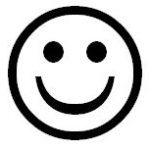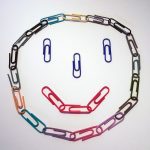Chapter 3: Codified Communication Systems
In this chapter, we conclude our discussion of foundational concepts by examining codified communication systems—sometimes called “codes”— and the process of codification. We first discuss what makes a codified communication system, and how they develop. We then examine the various dimensions along which codified communication systems can vary, which can be used to assess the utility of different codified communication systems for different communicative tasks.
“Code” is a word we use in everyday conversation to refer to a number of related, but somewhat different, things. As children, for example, we use codes to write secret messages to our friends. Software programmers write code for a living, and we know that every computer program we use, and every webpage we access, is written in some kind of code. (In most web browsers, clicking “view page source” lets you see the code behind the website you are viewing). The term “code” also plays an important of traditional models of communication, which describe communicators as encoding and decoding messages. In what follows, we will look at what makes a codified communication system (which is the label we will use for what are traditionally called “codes” in the context of communication), how and why these systems develop, and the role that codified communication systems play in creating understanding.
Definitions
Broadly defined, a code is a system in which one thing (e.g., a word, number, symbol) stands for something else (e.g., another word, symbol, or number; an idea or meme). Although we will talk about codes in more general terms, in this text, we are most interested in the role that they play in creating understanding. To distinguish between codes in the general sense and codes or code-like systems that people actively use to create understanding, we will call the latter codified communication systems.
For the purposes of studying how people create understanding, we define codified communication systems as organized systems that pair feature configurations and meme states, such that feature configurations consistently and systematically evoke similar meme states across various media.
This definition specifically calls attention to what we consider the essentials of codification—in other words, the properties that make something operate like a code. We can think of codification as a continuum: on one end, we have things that we could clearly and comfortably label as a “code”, which consistently exhibit all the properties we outline in this definition. On the other end of the continuum, we have things that do not exhibit these properties at all, and that we would not comfortably call a “code”. In between, we have things that exhibit these properties to a greater or lesser extent (e.g., more or less consistently, or exhibit some properties but not others). We prefer using the term codified communication system, rather than code, because it better acknowledges and includes some of the ways people communicate that fall along this continuum (rather than just things at the far end, that exhibit all the properties of codification uniformly).
The first essential of codification is the structural commonality of stimuli, reflected in the concept of a feature configuration. When something is highly codified, stimuli can take different physical forms (i.e., be instantiated in different ways) across different media systems, as long as they retain their key structural properties — that is, the same essential features, configured or arranged in the same way.
As an example, let’s consider the “smiley face”. A smiley face can evoke the same meme state whether it appears as pixels on a screen, graphite or ink on paper, pieces of fruit, an arrangement of paperclips, or exhaust plumes arranged against a blue sky.




All of those depictions differ in terms of the materials they use to create stimuli (i.e., their communication medium); they also differ in terms of size and scale, from less than an inch to perhaps 100 feet. However, they all share the same key structural features: all consist of a closed circle containing two horizontally-aligned dots in the upper half of the circle, and a broad, U-shaped curve in the bottom half of the circle. Additionally, this arrangement is structurally comparable to a smiling, human face. There are a many different ways to depict the smiley face using different media systems. However, across all of these, the basic configuration of key features in the stimuli remains the same.
The second essential of codification is that feature configurations consistently and systematically evoke similar meme states in different situations. When something is highly codified, feature configurations always evoke the same meme state(s), in a predictable way. Returning to our example, a smiley face (whether it is made of pixels, paper clips, fruit, or airplane exhaust) reliably evokes the same meme state (“happy face”, smiling, positive affect) across people and across contexts.
The third essential of codification is the existence of an organized system. Put another way, codes have syntax—that is, there is a degree of organization or structure evident and employed in a code. This syntax, or structure, occurs on two levels.
First, as discussed above, all codified systems consist of reliable associations between feature configurations and meme states. These associations are organized and systematic, and are the most basic, first-order form of syntax that all codified systems have. In this, it is also important to note that codified systems consist of sets or systems (hence the label) of such associations. A single stimulus-meme state association does not make a codified system. Rather, codified systems are made up of many sets of such associations together.
Second, most codified systems have conventions or rules about how stimuli can be combined into larger units or structures. These larger units can then evoke specific, more complex meme states than a single stimulus might on its own. For example, in language, each word (written or spoken stimulus) is associated with a definition (meme state); this is first-order syntax. However, there are also conventions that prescribe how words can be combined into phrases or sentences (e.g., in English, “Sam likes cake” is an acceptable sentence, but *“likes cake Sam” is not). These rules or conventions for combining and arranging stimuli constitute a second-order form of syntax.
As discussed above, not all means of human communication exhibit these properties to the same degree (or at all). Because of this, we again emphasize that it is more useful to think of systems used in human communication as being more or less codified – that is, on a continuum of codification – rather than being “codes” (or not codes) as a definitive category. When a means or system of communication meets most or all of the essential criteria listed here, we consider it to be highly codified; when it does not, we consider it to be less (or minimally) codified.
Examples of Codified Communication Systems
Any time there is a set of communicative practices that people use to reliably activate specific meme states with particular stimuli, we have a communication system that falls somewhere on our spectrum of codification. To figure out if something is such a system, we will look at behaviors, and ask if there is an organized system that activates the same meme states through the use of feature configurations, in a consistent manner. If there is, we consider it a codified communication system.
The following are some examples of (relatively) highly codified communication systems (traditionally referred to as “codes”). In all of these systems, there is a well-developed set of tight, reliable associations between feature configurations and specific meme states (first-order syntax). There are also well-defined conventions for how to combine stimuli into larger units (second-order syntax).
- Language – Language could be further reduced to written (visual) versions and spoken (auditory) versions as both display enough systematic differences that it would be productive to examine and understand why those differences exist.
- Modern Musical Notation System – This refers to how music is written, including information about the order and length of notes, time signature, key, and more.
- Mathematical Notion Systems – This refers to how math is written, including numbers, symbols for mathematical operations, and notation used in proofs (e.g., “QED”).
The following are some examples of moderately codified communication systems. In these systems, there are some reliable associations between feature configurations and specific meme states (first-order syntax), but some associations are looser or less consistent. Conventions for how to combine stimuli into larger units (second-order syntax) are not always well-defined.
- Kinesics – This refers to how we use our physical bodies to activate meme states in others. This system does not necessarily require an actual physical body as a medium. When we look at a comic strip the media system employed is paper and ink. Kinesics, however, are visible in the faces the comic strip characters make and the way their bodies are positioned.
- Vocalics – This refers to all the qualities of our voices that accompany the content, or the words, spoken. This can include pitch, rate, variation in pitch, accent, volume, articulation, etc. It, too, can be evident in a variety of different media systems. In fact, we would argue that what is referred to as “punctuation” in print can be understood as graphic indicators of a codified vocalic communication system. Commas, semi-colons, periods, ellipses, question marks, exclamation marks are all indicators of vocalic behavior. For example, person who posts something online in ALL CAPS is often told to “stop shouting.”
- Proxemics – This refers to how we used physical space to activate meme states in others. As with the kinesics, the proxemics can be evident in a variety of different media systems – animations, movies, photographs – and is not limited to use only between actual human beings.
- Physical Appearance – We present our physical selves a variety of ways to others. Some of these meme states get activated by qualities of our appearance less directly under our control (e.g., height, skin color, shape), some more directly under our control (e.g., hair color, weight).
Finally, the following are some examples of communication systems with a relatively low level of codification. In these systems, there are some established associations between feature configurations and specific meme states (first-order syntax), but many associations are not reliable or consistent. Generally, there are few to no established or shared conventions for how to combine stimuli into larger units (second-order syntax).
- Haptics – This includes all the ways we activate meme states via touching another person.
- Chronemics – This refers to how we can activate meme states via the use of time. Arriving late, arriving early, imposing on something unannounced, multi-tasking while someone is talking with you – these are all examples of how we use time to activate meme states.
- Artifacts and Environment – This includes what George Carlin refers to as “our stuff,” and how it activates particular meme states for those interacting with us. How we dress, what glasses we wear, our purses, backpacks, jewelry, and all the ways we manipulate and decorate our immediate environment (e.g., bedroom, office) can all be part of this communication system.
- Aesthetics – Various arts – e.g., painting, sculpting, acting, dancing, film production, music composition, music performance – employ codified communication systems in that they employ behavior and artifacts in rule-governed ways that systematically evoke particular meme states in others.
When a communication system is highly codified, its syntax is typically rigid, or fixed. As a result, meme states that are “encoded” using that system are usually “decoded”, or interpreted, in a highly similar fashion across multiple, different communicators.
For example, the syntax that governs modern music notation is fairly rigid: the same visual symbols (e.g., whole note) always correspond to the same, specific meme states and corresponding behaviors (e.g., play a note for a full beat in the time signature). As a result, anyone who uses or reads the same sheet of printed music will have highly similar meme states activated. (This is what allows them to play a piece of music as a composer intended). Modern mathematical notation systems are similar. A mathematical equation has no room for ambiguity; multiple communicators are able to interpret that equation exactly the same way. Not surprisingly, two functions that early computers were programmed to do were various mathematical activities and – when the necessary accessory hardware was created – play music. Why could computers do math and music so early? Because math and music are highly codified, so they could be programmed relatively easily.
On the other hand, when a communication system is not highly codified, its syntax is less rigid. The less rigid syntax is, the more we can think of a system’s structures or conventions as probabilistic or variable (rather than fixed). For instance, people’s use of kinesic behaviors like facial expressions or gestures only sometimes evoke (and are intended to evoke) specific meme states in consistent and/or systematic ways. It will likely be a long time before current commercial AI systems – for example, Apple’s Siri™, Amazon’s Echo™, Microsoft’s Cortana™ – can show average adult human skills at responding appropriately to kinesic or vocalic communicative behavior. This is because these communication systems are characterized by much less syntactic rigidity than musical or mathematical notation systems, or even spoken and written language. Generally, it is more difficult to reliably interpret messages when the communication systems they use are less codified.
Development of Codified Systems
How, and why, does codification occur? In other words, how do we come to have codified communication systems? To answer this question, it is useful to first consider some basic properties of human cognition – that is, some characteristics of the way that they think. Here, we will focus on two general, related tendencies: seeking efficiency and seeking patterns.
First, in general, people have evolved to be as efficient as possible across many different domains – in other words, we seek to minimize the amount of energy required to obtain a given output or outcome. In the case of creating understanding, this means that people generally want to use as little effort or work as possible to successfully activate a desired meme state in another person’s mind. Second and related, in general, people seek and like predictable patterns and regularities. Regular occurrences, or reliable patterns, allow us to better predict events in our environment. They can also help us be more efficient, because they allow us to go right to what we know will work or happen, without having to waste energy guessing or trying something unsuccessful.
These basic tendencies help us understand how codification emerges in communicative interactions. Once communicators successfully create understanding using a particular set of stimuli, they have established that this set of stimuli “works” for this purpose. When they want to activate the same meme state again, the most efficient thing to do is to return to those same stimuli (i.e., reuse the same pattern). A behavior will be reproduced if it is effective at activating a desired meme state, and reproduced widely if it is widely effective. As a set of reliable associations between behaviors (or other stimuli) and specific meme states are formed, a codified communication system emerges.
Does Communication Require Codified Systems?
For communication to “work”—that is, for the stimuli we present to activate or create the meme state we intend—does that stimuli have to be codified? In other words, do we need highly codified systems to communicate?
Much of human communication takes places through a shared language. Shared language qualifies as a codified communication system: languages are systems in which feature configurations (e.g., words) are reliably associated with meme states (e.g., definitions of those words), in structured and organized ways. It is also the case that much of our communication employs nonverbal behavior as well. Any number of textbooks that address nonverbal communication identify and describe various nonverbal “codes”—a term they use to refer to the organized systems through which people systematically associate different forms of nonverbal behavior with different “meanings” or meme states. Many traditional definitions of communication make reference to some sort of “shared code” or “shared signal system”. Given this focus on language and nonverbal “codes” in scholars’ discussions of communication, it intuitively seems that communication would be dependent on some sort of shared, highly codified communication system (i.e., code).
We contend that a shared codified communication system is not an essential component of a communicative event—in other words, it is possible to communicate without a “code”. However, codified systems do facilitate communication, and can be an emergent phenomenon following repeated communicative events. Put another way, we do not have to have codified systems to communicate, but they do make communication easier—so much so that even if we start communicating without a codified system, we will likely develop one along the way, if we communicate for long enough (as described just above).
As a way to illustrate this point, consider the game Charades. For the few readers unfamiliar with this game, this is the general procedure: Two teams compete against each other. One person on one team is given a prompt that is not shared with her teammates. This prompt could be many different things: a song title, a movie, a popular phrase, or any number of general concepts (“dance party”, “bookworm”). The player given the prompt must communicate this prompt to her teammates without the use of any words, language, or sound. The player can only use gestures. Her teammates shout out their inferences about what she is trying to convey until they either get it right or a set amount of time is up.
If we were to find a handful of people who have never played the game before and entice them to play, it is highly likely they will be naïve to any gestures or behaviors that other more experienced players may use when playing. They must literally “make it up as they go along.” Yet, despite this inexperience, they will probably be successful in several of their attempts to infer the right prompts.
By most definitions of communication, and certainly the definition we have employed in this book, Charades clearly involves communication. And yet our hypothetical team of Charades novices are managing to successfully communicate in the absence of any specific, previously established, shared codified communication systems. We concede by the end of several rounds of play, our novices will likely have developed a very basic, embryonic Charades system (where, for example, the same gestures are systematically used to activate “sounds like”, or “book”, or “movie”). However, their initial successes show us that it is possible to communicate without a shared, highly codified communication system.
Properties of Codified Communication Systems
All codified communication systems have a range of different characteristics, or qualities. By comparing some of these key properties, we can examine how codified communication systems vary. This allows us to compare and contrast the utility of different systems for the communicative task at hand.
Syntactic Complexity
First, communication systems vary in the complexity of their syntax. Some codes have a relatively straightforward structure, defined by straightforward rules. Morse code, for example, consists of a series of combinations of dots and dashes, with a different combination representing each letter of the English alphabet. Syntactically, this code is fairly simple. The same cannot be said of the syntax that governs mathematical communication. For the average person, the syntax of mathematical communication is more complex: the notation system (first-order syntax) is more extensive, and there are many rules about how different components can or cannot be combined (second-order syntax). For example, there are definite rules regarding orders of operations in mathematics, and people use mnemonics like “Please Excuse My Dear Aunt Sally” or PEMDAS to help them remember this part of the system’s relatively complex syntax.
Commonality of Use
We can also compare and contrast codified communication systems based on how widespread their use is. Codified communication systems with wide commonality of use allow people of different cultures and backgrounds to readily communicate about content areas amenable to those codified systems. For example, we can assume that some aspects of kinesics and vocalics might be common the world over. This is likely because portions of these communication systems are part of our mammalian heritage. We can smile, frown, grit our teeth and growl and people across the planet will interpret these behaviors in a highly similar fashion. Similarly, two mathematicians from different countries who speak different languages might not be able to converse about the weather very easily, but they can communicate about anything that can be expressed in mathematical formula and equations. This is because the ways we communicate via mathematical “code” are extremely widespread, global even. Our modern mathematical notation system is not part of our genetic inheritance; it is an invented (i.e., conventional) system. Like the modern musical notation system, mathematical notation has become standardized across much of the world. In contrast, some other communication systems – such as languages that are spoken only in a small geographic area, or by a handful of people – are not widely or commonly used.
Limits to Topicality
This property refers to the range of possible ideas or meme states that can be addressed by a communication system. This is particularly important to consider when assessing how a codified communication system can be used. As discussed earlier, the primary function of communication is the activation of meme states in another communicator. Not all communication systems do this equally well for all possible meme states. Mathematical codes are excellent for clearly communicating mathematical ideas, but poor for discussing the weather, politics, or how your day at school went. Of all the systems humans commonly use, language probably has the greatest capacity for topicality. Certainly, there are ideas we have “trouble putting into words.” But in the end, words – language – is still our most versatile and effective communication system we have available to efficiently activate the greatest range of meme states with the best possibility of success.
Summary and Conclusion
In this chapter, we offered a definition of codified communication systems focused on creating understanding. We provided some examples of codified communication systems that are frequently used to activate meme states and help communicators effectively create understanding. We made the argument that we do not have to have a codified system to successfully communicate. However, codified communication systems do facilitate communication; as a result, they often emerge across repeated communicative interactions if we do not start with a shared codified system. We then articulated a set of key properties—syntactic complexity, commonality of use, and limits to topicality—that can be used to assess codified communication systems, as well as compare and contrast them with each other. Identifying a set of properties common to all codified communication systems also helps us recognize the functional commonalities they all share.
References
Shannon, C. E., & Weaver, W. (1949). The mathematical theory of communication. Urbana: University of Illinois Press.
